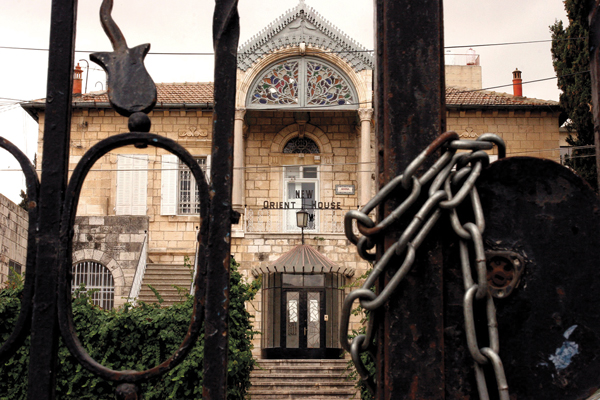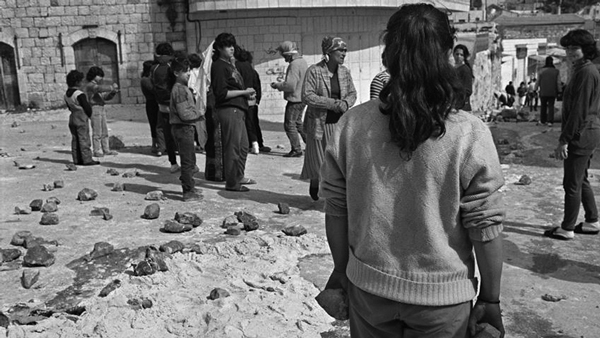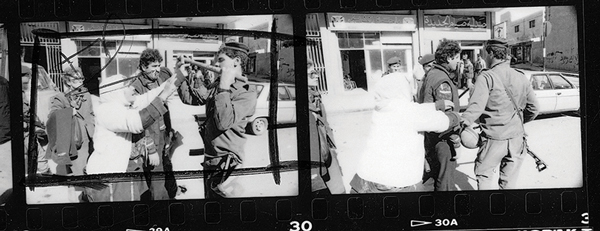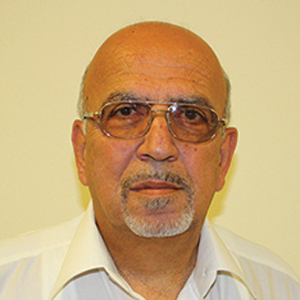
A reflection on the events that happened 30 years ago requires that we consider the prevailing situation prior to the popular Intifada of 1987 – so many changes have occurred since that time. Ever since the early years of occupation, Palestinian politics have focused on liberation from the Israeli occupation (the approaches may have changed), even though for the average Palestinian, relieving economic hardship was an immediate concern as well. There were those who felt that under occupation, no real development could take place. Others considered development for the sake of steadfastness an acceptable strategy towards independence and a tool that could provide a practical, parallel path for political activism under prolonged occupation.
In the years leading up to the Intifada, 1982 marked a turning point in Palestinian attitudes towards both occupation and self-understanding. More and more, universities, grassroots organizations, and professional unions had become centers of political activism. A new leadership had emerged (often referred to as new Palestinianism) that was characterized by motivation, commitment, self-confidence, and self-reliance, and had no illusions regarding the relationships between the various parties in the Middle East conflict.i In a very short time, the emerging grassroots organizations had attained widespread support despite continued attempts of the Israeli authorities – and other countries for that matter – to create alternative forms of leadership by using money and other sources of power as incentives. Grassroots organizations continued to prosper because they fostered social cohesion.ii
The popular Intifada was sparked on December 8, 1987, when four Palestinian laborers were killed by an Israeli vehicle in Gaza. Widespread demonstrations erupted, and the Israeli response was to crush the uprising by force – as expressed by Yitzhak Rabin, then Israeli minister of war, who within days issued the “break their bones” order that was taken literally, and at times deliberately carried out with rocks. Palestinians persevered in their protests, and on December 18, 1987, the United National Leadership of the Uprising (UNLU) issued its first communiqué, calling for an independent Palestinian state. Commercial and general strikes began to be held all over the OPT.
It is important to note that the economic situation in the OPT was not among the factors that had contributed to the outbreak of the Intifada, nor did it significantly deteriorate from pre-1987 conditions during the Intifada’s course. People worked in the morning, taking care of most of their business, and went on strike around noon. The disposable per capita income in the OPT amounted to approximately US$1,500,iii almost 200,000 Palestinians continued to work in Israel, and remittances from Palestinians in the diaspora further contributed to the stabilization of the economic situation despite ongoing unrest and work stoppages. What sparked the outbreak of the Intifada was dismay over the humiliating conditions of the occupation and the pervasive violent actions that had been continuously carried out against Palestinians by Israeli forces.
♦ During the first year of the first Intifada, 396 Palestinians were killed and more than 12,000 jailed; schools and universities were closed by the Israeli occupation authorities.
Palestinians persevered and organized themselves to deal with the new conditions. Neighborhood committees were established in every community: a protection committee guarded the neighborhood and alerted the residents of impending attacks by the Israeli army or settlers; women organized themselves in so-called “strike forces” to rescue arrested youth from the hands of Israeli soldiers; first aid committees were formed to treat the wounded; an alternative education system was established for each neighborhood to enable students to continue their education; and social committees were established to address the needs of the poor. Following the mass resignation in March 1988 of 625 Palestinian police officers working under the Israeli police force, reconciliation committees were formed to resolve conflicts. Agricultural committees were established in each neighborhood to promote backyard farming and food security. Israeli products were boycotted whenever there was a Palestinian substitute available.

Beit Sahour went even further than other towns and bought 18 cows to provide milk to its population, which led Israel to launch its Wanted 18 Campaign.iv Furthermore, the people of Beit Sahour refused to pay taxes, adopting the slogan “No taxation without representation,” which led Israel to impose an extended curfew on the city, arrest more than 250 of its residents, and later confiscate the machinery and furniture of the businesses that refused to pay taxes. A United Nations resolution protesting these measures was vetoed by the United States. In response, the residents of Beit Sahour and other Palestinian cities decided in July 1988 to hand in their ID cards, an act that was considered civilian mutiny against the Israeli occupation.
Jerusalem was the coordination center of Intifada activities. While the UNLU remained underground, Palestinian national institutions in Jerusalem were proactive. In May 1988, a draft proclamation of independence was announced by the late Faisal Husseini, with more than 500 signatures from local leaders. Subsequently, Faisal Husseini was arrested, and the Arab Studies Society was closed by Israel. On November 15, 1988, the 19th Palestine National Council (PNC) session in Algiers proclaimed the Declaration of Independence of the State of Palestine with Jerusalem as its capital.
Regrettably, by the beginning of 1990, the popular Intifada started to suffer from factionalism. Mass popular demonstrations were replaced by factional activities. “Political money,” introduced by outside players, led many to abandon their involvement in Intifada activities.
On August 2, 1990, Iraq invaded Kuwait and over months resisted all efforts that urged it to withdraw its forces. When it became clear that war was imminent, the Palestinian leadership sent a letter to the Iraqi leadership (speaking in the name of the UNLU and delivering it through the PLO leadership in Tunis) in which it asked that Iraq announce its readiness to withdraw from Kuwait if Israel were to withdraw from the OPT. Regrettably, the drums of war were louder. On January 17, 1991, the United States led coalition forces that included Saudi Arabia, Egypt, Syria, the United Arab Emirates, and Bahrain in launching “Operation Desert Storm” on Iraq. Israel imposed a total curfew on the OPT that lasted until the war ended on February 27, 1991.

In the spring of 1991, the local Palestinian leadership took the initiative to establish the Strategic Planning Unit (which had to be operated through a third-party institution because the Orient House had been closed during the Intifada) in order to develop an action plan for the rehabilitation and reconstruction of the OPT, which also involved the reopening of universities and hospitals.
The United States, in the aftermath of the war, started its initiative to promote the Middle East Peace Conference in order to reward the coalition of the willing that had supported its war against Iraq: Syria hoped for the return of the Golan Heights, and Egypt was hoping to receive economic boosts.
In Palestine, the Strategic Planning Unit was developed into the Technical Committee, in which more than 500 Palestinian professionals worked voluntarily to put forward the blueprints for a Palestinian state and to support the official Palestinian delegation in the peace negotiations.
These efforts culminated in the inauguration of the Madrid Conference in October 1991.
» Jad Isaac holds a PhD from the University of East Anglia, United Kingdom. The recipient of numerous awards, he is the director general of the Applied Research Institute-Jerusalem (ARIJ), a leading Palestinian center that conducts research on agriculture, environment, land use, and water. He headed the Palestinian delegation for the environmental working group in the multilateral talks and is an adviser to the Palestinian Negotiations Affairs Department.
i. The signing of the Camp David Agreement between Israel and Egypt (1978) was interpreted as an abandonment of the Palestinian cause and therefore not welcomed by Palestinians; Arab nations were generally more preoccupied with the Iran-Iraq war (1980–88); and there was widespread dismay among Palestinians over the Israeli invasion of Lebanon and the massacres of Sabra and Shatila (1982). The expulsion of the PLO’s leadership from Lebanon (which was moved to Tunis in 1982) was perceived as a further attempt to marginalize the PLO and ignore Palestinian aspirations for freedom, causing tensions to rise among Palestinians.
ii. Increased support from international bodies, many of them communist organizations, led to the establishment of strong and credible NGOs, such as the Palestinian Medical Relief Society, the Palestinian Agricultural Relief Committees, and others.
iii. Meron Benvenisti, 1987 Report: Demographic, economic, legal, social and political developments in the West Bank, The West Bank Data Base Project, Jerusalem Post, available in print at The Applied Research Institute, Jerusalem.
iv. For more details, visit http://www.thealliance.media/just-vision-impact-campaign-wanted-18-little-known-story-1st-intifada/.


